Hello, everybody! This is the last part of the series! Part 1 and part 2 shows lenses that I can call “approachable” but in this part, I will be showing you some of the really exotic Nikkors that were made and is usually off-limits to the regular photographer. They’re the lenses that Nikon fans dream of owning one day. If there are posters of these then people will probably hang them in their bedrooms just like how kids back then have sports cars on the walls of their bedrooms. I had the Beatles and Queen on my bedroom walls but I’m kind of an odd kid anyway. Enjoy this last part of the World of F-mount Nikkors series.
Fisheye:
We’re going to start this article with fisheye lenses! I have owned several and used them for my job before to take pictures and use them as light probes. It’s more technical than creative and they get the job done with their really wide picture angle.
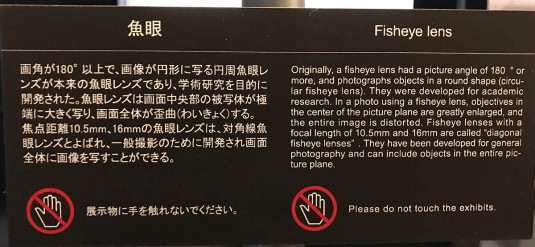 This is what Nikon has to say about fisheye lenses. Nikon made plenty of fisheye lenses so you can consider them to be one of the leaders in this field. Fisheye lenses were designed for the scientific and engineering fields but people soon found a creative use for them.
This is what Nikon has to say about fisheye lenses. Nikon made plenty of fisheye lenses so you can consider them to be one of the leaders in this field. Fisheye lenses were designed for the scientific and engineering fields but people soon found a creative use for them.
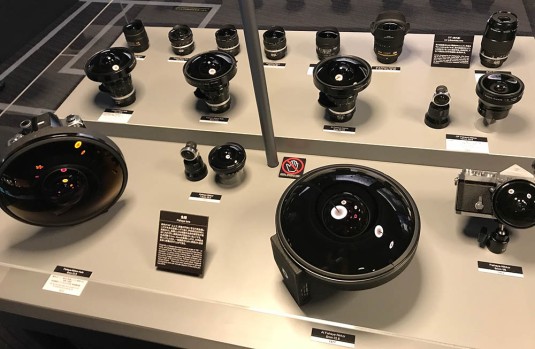 And here are the beautiful fisheye lenses! I have never seen so many of these in a table!
And here are the beautiful fisheye lenses! I have never seen so many of these in a table!
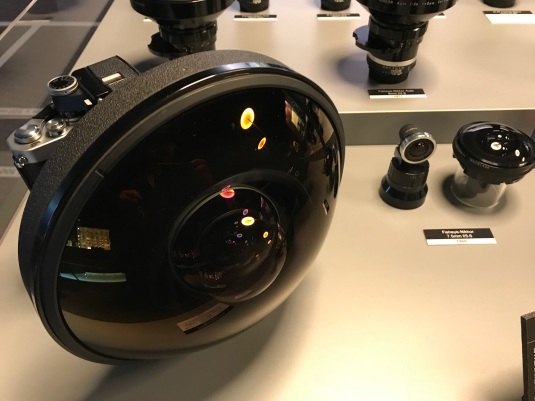 Oh, just look at this Fisheye-Nikkor 6mm f/2.8 Ai-S! I would love to own one but the price is something that is something that I am yet to afford. One day, I will own one of these.
Oh, just look at this Fisheye-Nikkor 6mm f/2.8 Ai-S! I would love to own one but the price is something that is something that I am yet to afford. One day, I will own one of these.
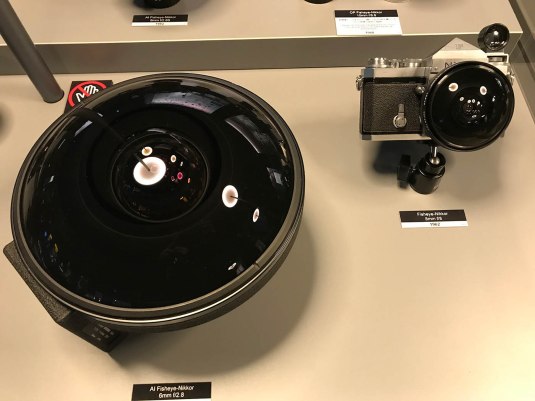 It dwarfs the Fisheye-Nikkor 8mm f/8 at he corner of the picture. Just look at that thing!
It dwarfs the Fisheye-Nikkor 8mm f/8 at he corner of the picture. Just look at that thing!
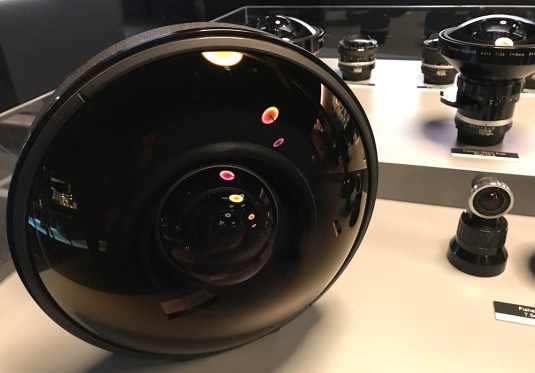 Here’s another view. You can actually get your feet in-frame with this lens because it can cover more than 180 degrees. This is important for scientific purposes where the setup is facing the sky and you can capture the entire sky plus the horizon with the ground on it.
Here’s another view. You can actually get your feet in-frame with this lens because it can cover more than 180 degrees. This is important for scientific purposes where the setup is facing the sky and you can capture the entire sky plus the horizon with the ground on it.
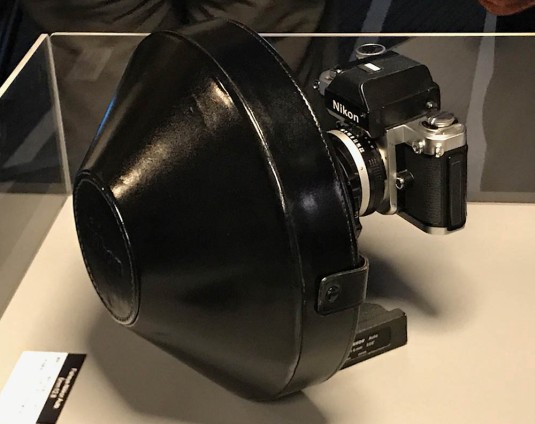 Lens cap, you say? Here’s a lens cap for you! I am sure that this lens cap costs more than a brand-new camera these days. Milling the cap from metal isn’t practical so it’s made of leather. I’m not sure if this is leatherette but I’m just assuming that it’s natural. The cap is not part of the display and it was recovered from storage just for us to see how it works.
Lens cap, you say? Here’s a lens cap for you! I am sure that this lens cap costs more than a brand-new camera these days. Milling the cap from metal isn’t practical so it’s made of leather. I’m not sure if this is leatherette but I’m just assuming that it’s natural. The cap is not part of the display and it was recovered from storage just for us to see how it works.
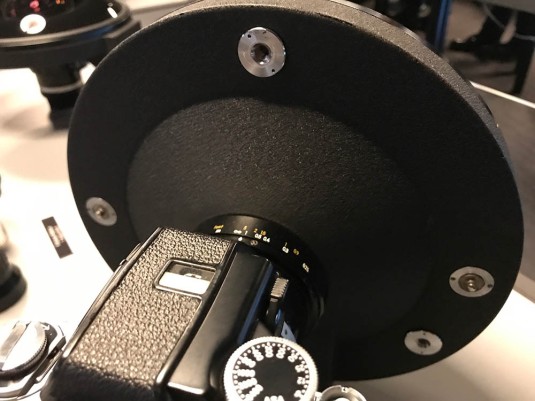 Here’s the back of that monster. See the 2 nipples at the 9:00 and 3:00 position? That’s for the lens cap to clip in to. The 3 holes (2 shown) has screw-in threads for you to attach legs so your setup will be very-well supported when you have this thing facing the sky. There is a tripod mount casted with the body but it can be unbalanced. The casting for the body is tough, I am sure. Having the legs there is the right decision. Well done, Nikon engineer!
Here’s the back of that monster. See the 2 nipples at the 9:00 and 3:00 position? That’s for the lens cap to clip in to. The 3 holes (2 shown) has screw-in threads for you to attach legs so your setup will be very-well supported when you have this thing facing the sky. There is a tripod mount casted with the body but it can be unbalanced. The casting for the body is tough, I am sure. Having the legs there is the right decision. Well done, Nikon engineer!
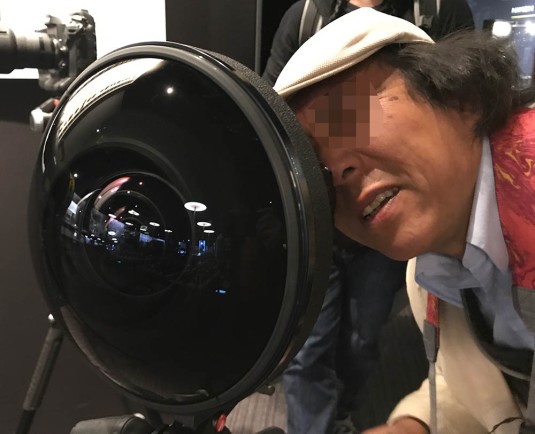 Time to peek into this thing! It’s so big that it dwarfs everything close to it!
Time to peek into this thing! It’s so big that it dwarfs everything close to it!
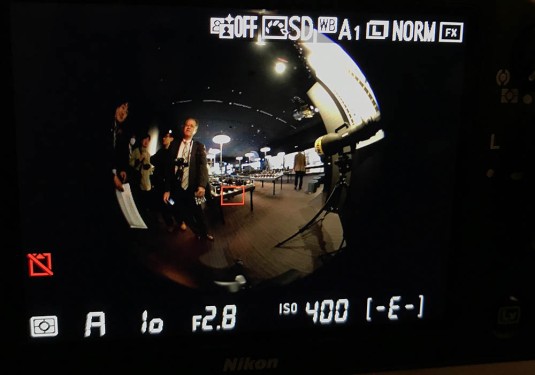 This is what the Live View looks like. See how it captured the tripod legs and my foot? I’m in the frame but it’s just too dark for you to see properly. You want wide? This is wide!
This is what the Live View looks like. See how it captured the tripod legs and my foot? I’m in the frame but it’s just too dark for you to see properly. You want wide? This is wide!
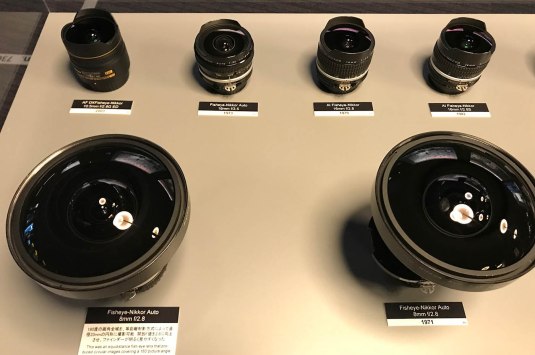 Here are the smaller fisheye lenses made by Nikon. Nikon makes some of the best lenses in this category and the AF DX Fisheye-Nikkor 10.5mm f/2.8G ED at the corner is very nice and is probably the most affordable one. I had one before and I liked it a lot. Very sharp!
Here are the smaller fisheye lenses made by Nikon. Nikon makes some of the best lenses in this category and the AF DX Fisheye-Nikkor 10.5mm f/2.8G ED at the corner is very nice and is probably the most affordable one. I had one before and I liked it a lot. Very sharp!
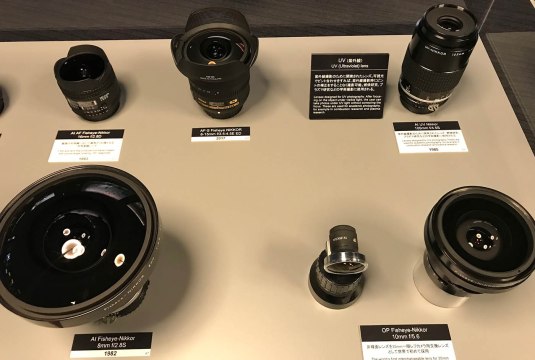 Looks like the UV-Nikkor 105mm f/4.5 Ai-S lens is lost. Somebody should show him how to get back to his table. UV-Nikkors were made for special scientific purposes. That fisheye lens at the corner is the Fisheye-Nikkor 10mm f/5.6 OP, it is another lens made for special purposes and “OP” means orthographic projection. Meteorologists use this for their job.
Looks like the UV-Nikkor 105mm f/4.5 Ai-S lens is lost. Somebody should show him how to get back to his table. UV-Nikkors were made for special scientific purposes. That fisheye lens at the corner is the Fisheye-Nikkor 10mm f/5.6 OP, it is another lens made for special purposes and “OP” means orthographic projection. Meteorologists use this for their job.
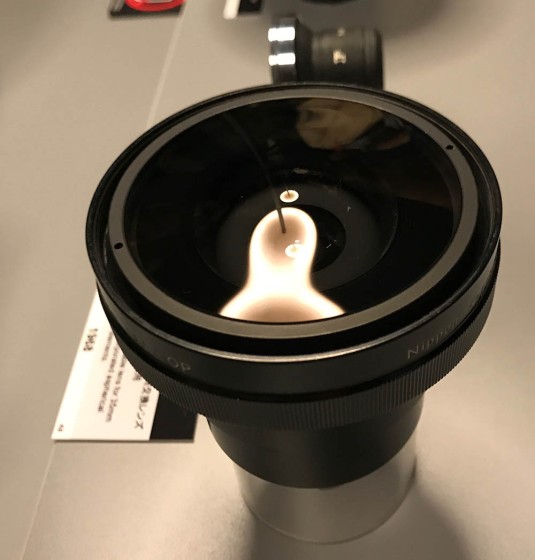 Observe the front element of the Fisheye-Nikkor 10mm f/5.6 OP and find something weird with it. Ok, I will save your time and point it out to you, the reflections are bent because the front is an aspherical element meaning it’s not a cut from a perfect sphere so it’s a bit anisotropic (don’t know if I can use that). Aspherical elements are either moulded or are hand-ground. They are expensive to make because they’re unconventional. If you watch a video about grinding lenses, you will see that they use a hemispherical cup for grinding and polishing the lens elements and I don’t think you can do that with aspherical ones.
Observe the front element of the Fisheye-Nikkor 10mm f/5.6 OP and find something weird with it. Ok, I will save your time and point it out to you, the reflections are bent because the front is an aspherical element meaning it’s not a cut from a perfect sphere so it’s a bit anisotropic (don’t know if I can use that). Aspherical elements are either moulded or are hand-ground. They are expensive to make because they’re unconventional. If you watch a video about grinding lenses, you will see that they use a hemispherical cup for grinding and polishing the lens elements and I don’t think you can do that with aspherical ones.
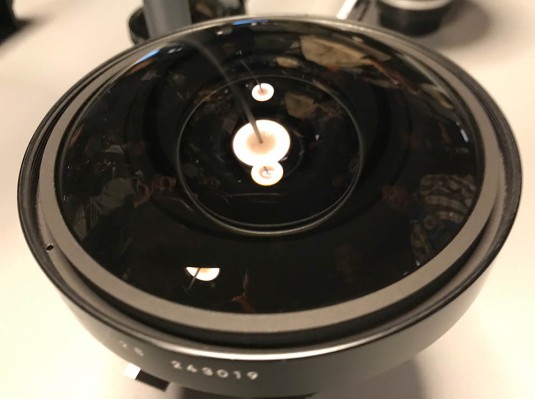 Here’s a spherical front element just to give context to what I just said. Now, compare it with the previous picture and you will get what I mean. Aspherical elements are needed to help manipulate how light refracts to correct for aberrations and distortion.
Here’s a spherical front element just to give context to what I just said. Now, compare it with the previous picture and you will get what I mean. Aspherical elements are needed to help manipulate how light refracts to correct for aberrations and distortion.
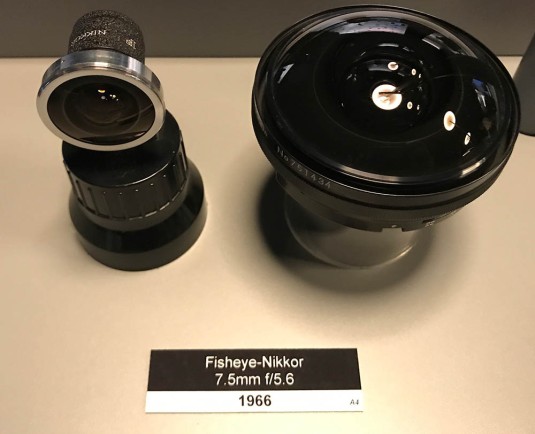 This is something that I would like to own one day. Made in 1966, this is one of the “firsts” for the 35mm film format. There is a dial at the body where you can dial-in which filters you want to use this lens. It was a masterpiece of engineering and miniaturization.
This is something that I would like to own one day. Made in 1966, this is one of the “firsts” for the 35mm film format. There is a dial at the body where you can dial-in which filters you want to use this lens. It was a masterpiece of engineering and miniaturization.
That’s it for fisheye lenses! If you haven’t shot with one then first borrow one from your friend and see if it’s something that you will have a use for or not because they are very specialized and if you don’t have any practical use for one then it might end up wasting your money because it will just end up being stored in a dry box!
Normal Zoom:
Normal zooms are zoom lenses that cover the mid-range focal lengths. They are are used by almost every event photographers these days in the form of the 24-70/2.8 zoom lenses. They are handy because you save space in your bag by having several focal lengths that you can use without having to change your lens. If you are shooting events then this can mean losing a shot or getting it. Prime lenses usually have better image quality but you only have the option of using one focal length per lens and zooms are the compromise.
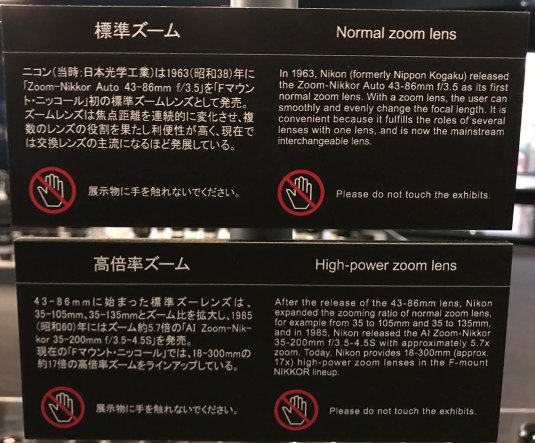 Nikon made plenty of great zoom lenses, they even pioneered the technology for it here in Japan. Before Nikon made the Zoom-Nikkor 43-86 f/3.5 Auto lens, zoom lenses were so expensive and no other Japanese company made them. Just like what’s printed here, the zoom lenses have now become the mainstream type of lenses because they are so easy to use and it offers the first-time camera owner a chance to try various focal lengths before they settle into which type of photography they wanted to specialize in and invest in the more specialized and expensive lenses. Some don’t even upgrade and just stuck to their first zoom lens until the camera rots inside the dry box.
Nikon made plenty of great zoom lenses, they even pioneered the technology for it here in Japan. Before Nikon made the Zoom-Nikkor 43-86 f/3.5 Auto lens, zoom lenses were so expensive and no other Japanese company made them. Just like what’s printed here, the zoom lenses have now become the mainstream type of lenses because they are so easy to use and it offers the first-time camera owner a chance to try various focal lengths before they settle into which type of photography they wanted to specialize in and invest in the more specialized and expensive lenses. Some don’t even upgrade and just stuck to their first zoom lens until the camera rots inside the dry box.
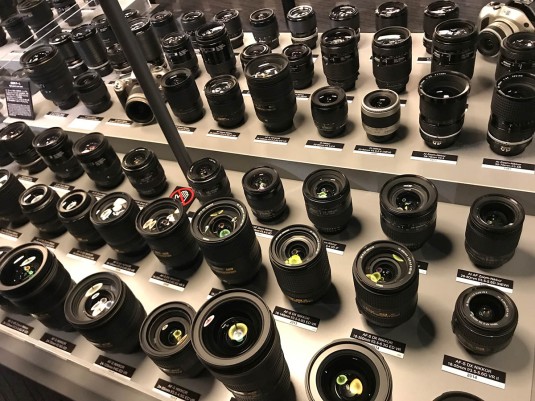 This is Nikkor zoom heaven! wow! Somebody give me an adult diaper!
This is Nikkor zoom heaven! wow! Somebody give me an adult diaper!
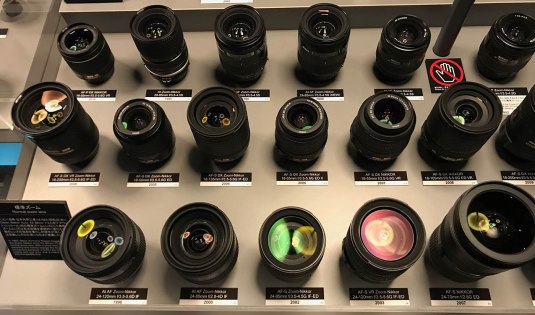 Here are some recent models of Zoom-Nikkors. From the humble kit-lens to the high-end zooms made for professionals. I can’t see anything that was made in the 1970s here.
Here are some recent models of Zoom-Nikkors. From the humble kit-lens to the high-end zooms made for professionals. I can’t see anything that was made in the 1970s here.
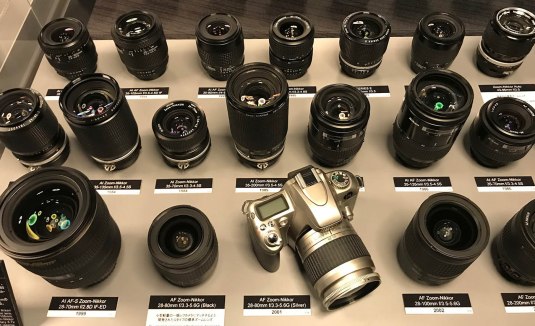 More pictures from the same table. I really dislike that silver camera, it looks like a toy.
More pictures from the same table. I really dislike that silver camera, it looks like a toy.
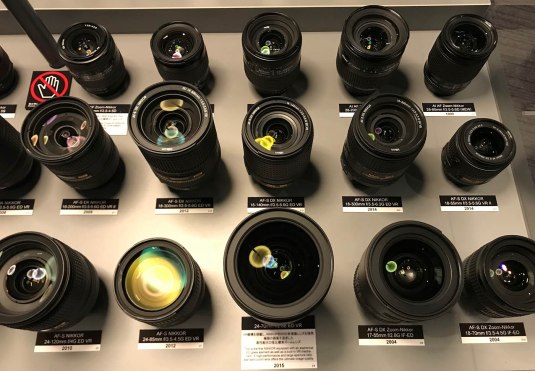 Again, from the same table. Such lovely works of engineering.
Again, from the same table. Such lovely works of engineering.
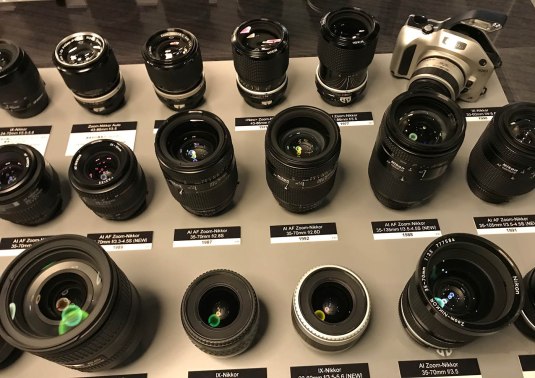 Here’s the final picture. The Zoom-Nikkor 43-86mm f/3.5 Auto is being poo-pooed by some because of a couple of reviews on the net. It really isn’t as bad as some people make it out to be specially if you consider when this lens was made and how significant this lens is to the history of photography. Zoom lenses were too expensive for average people to afford but this lens made it possible for the average person to use and enjoy zoom lenses. It was made cost-cutting in mind and of course, some things will have to be compromised.
Here’s the final picture. The Zoom-Nikkor 43-86mm f/3.5 Auto is being poo-pooed by some because of a couple of reviews on the net. It really isn’t as bad as some people make it out to be specially if you consider when this lens was made and how significant this lens is to the history of photography. Zoom lenses were too expensive for average people to afford but this lens made it possible for the average person to use and enjoy zoom lenses. It was made cost-cutting in mind and of course, some things will have to be compromised.
That’s it for the normal zoom section. This is probably the most familiar lens type for the current generation of photographers who grew up in the generation where zoom lenses dominated the market. They’re more difficult to design so they only became mainstream during the computer age. In fact, zoom lenses were generally terrible during its infancy and professionals avoided using them until recently where computers helped a lot in the design and engineering of lenses and this resulted in much better zoom lenses.
Telephoto Zoom:
Nikon made plenty of great tele-zoom lenses. Nikon gave us the 70-200/2.8 line of lenses. The first lens of this type is the 80-200/2.8 zoom of the early ’80s. Before that, Nikon made the Zoom-Nikkor 80-200mm f/4.5 Auto lens in 1969 and that soon set the standard for the pro tele-zoom lens type and everybody else just followed the lead. Even earlier than this, Nikon made some very interesting zooms that would put them in the apex of zoom lens development and I will show you some of them here.
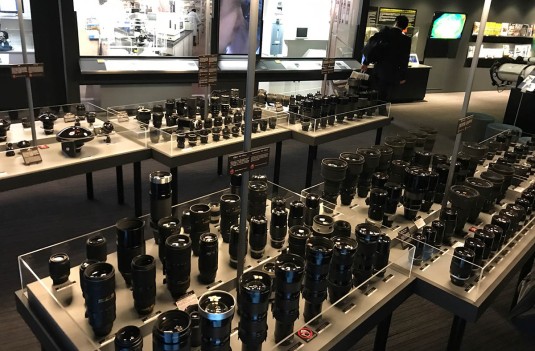 Here is the table for the telephoto zoom section. The more exotic ones aren’t displayed in this section and we will get to those later. The earlier telephoto zooms were really big but as technology and design advanced, Nikon began them smaller and smaller.
Here is the table for the telephoto zoom section. The more exotic ones aren’t displayed in this section and we will get to those later. The earlier telephoto zooms were really big but as technology and design advanced, Nikon began them smaller and smaller.
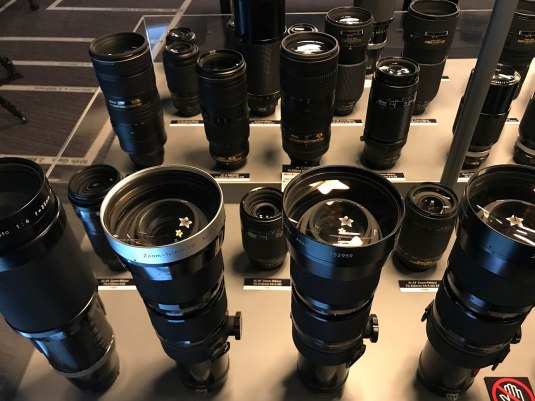 These are the forerunners to the pro telephoto zooms that we have today. They weigh a lot and are at least 3x the size of their modern counterparts. I had the chance to overhaul some of these lenses before and I will write articles for these when I have the time. Check the smaller lenses at the back, some of those have similar zoom ratios and focal lengths as the bigger ones you see at the front. That is how far we have advanced 4-5 decades.
These are the forerunners to the pro telephoto zooms that we have today. They weigh a lot and are at least 3x the size of their modern counterparts. I had the chance to overhaul some of these lenses before and I will write articles for these when I have the time. Check the smaller lenses at the back, some of those have similar zoom ratios and focal lengths as the bigger ones you see at the front. That is how far we have advanced 4-5 decades.
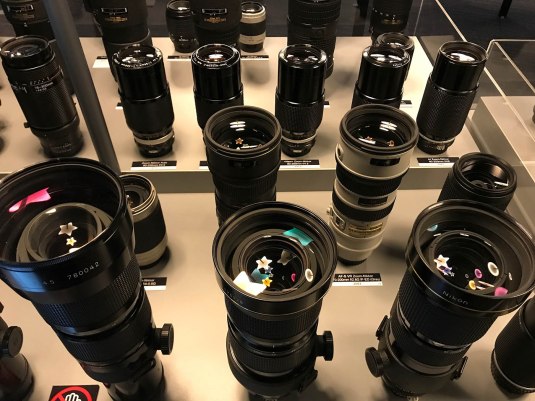 Here is another picture of the telephoto zoom exhibit.
Here is another picture of the telephoto zoom exhibit.
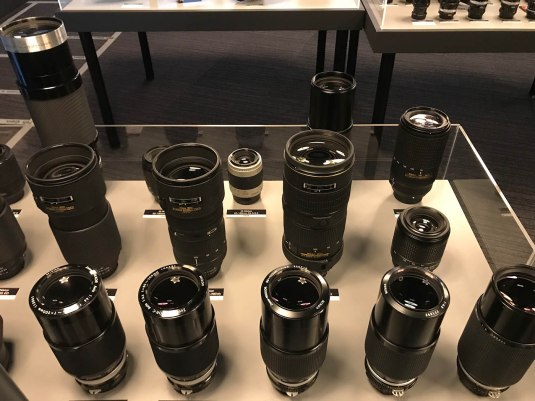 And here is a closer view of this section of the table above. The lenses at the front belong to the famous 80-210/4.5 family of lenses. The lens to the right is the final and best one in the family, the Zoom-Nikkor 80-200mm f4 Ai-S is a great lens and it used to cost a lot back in the day. This family of lenses gave the us a light and practical lens with a speed that is fast enough for professionals to use for shooting outdoor sports. The consistent aperture is important and that sets it apart from the variable aperture zooms that amateurs use. It is important that a pro zoom lens has a constant aperture because you don’t want to take a new reading every time you zoom in or out.
And here is a closer view of this section of the table above. The lenses at the front belong to the famous 80-210/4.5 family of lenses. The lens to the right is the final and best one in the family, the Zoom-Nikkor 80-200mm f4 Ai-S is a great lens and it used to cost a lot back in the day. This family of lenses gave the us a light and practical lens with a speed that is fast enough for professionals to use for shooting outdoor sports. The consistent aperture is important and that sets it apart from the variable aperture zooms that amateurs use. It is important that a pro zoom lens has a constant aperture because you don’t want to take a new reading every time you zoom in or out.
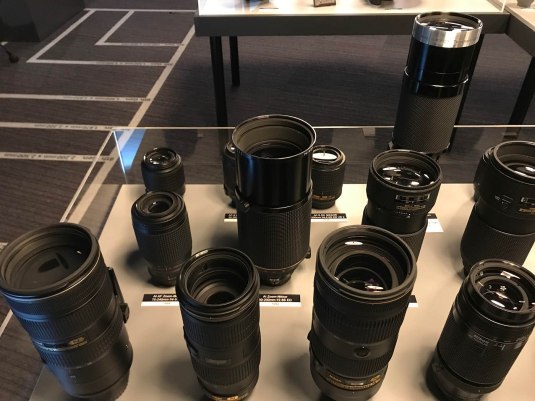 Finally, here’s a view from the other side.
Finally, here’s a view from the other side.
Telephoto zoom lenses are a staple these days. Together with wide zooms and the normal zooms, they form the backbone of almost every professional’s kit. They are usually used by camera makers to showcase how good their technology is because just like the normal zooms, telephoto zooms are also difficult to design and manufacture.
Exotic Lenses:
This is where things get really expensive and out-of-reach for the regular photographer. I would like to own some of the things shown here but it’s either too expensive for me or I just don’t have any practical uses for these. Storing these may also be a problem and this is one reason people just give them up and end up getting fungus and other nasty stuff in the inner surfaces of the lens. If the lens was once owned by a pro or a news company, it is possible that they were used in a rough manner. I doubt that the news companies use proper storage for these lenses suck as a proper dry cabinet for these because these are too big to fit into standard-sized dry cabinets.
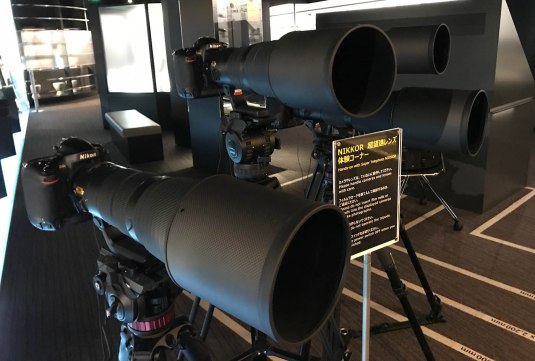 Be sure to follow what’s printed on this card! If you accidentally tipped this thing over it is going to be one of the most expensive mistakes in your life! Just look at the size of that hood! it’s bigger than a paint tin! I suppose these hoods aren’t cheap either.
Be sure to follow what’s printed on this card! If you accidentally tipped this thing over it is going to be one of the most expensive mistakes in your life! Just look at the size of that hood! it’s bigger than a paint tin! I suppose these hoods aren’t cheap either.
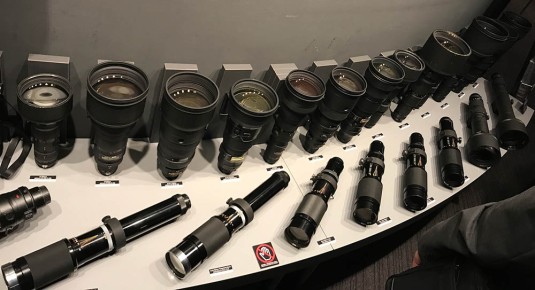 Wow! Just look at all those big lenses! Good luck finding filters for some of these lenses!
Wow! Just look at all those big lenses! Good luck finding filters for some of these lenses!
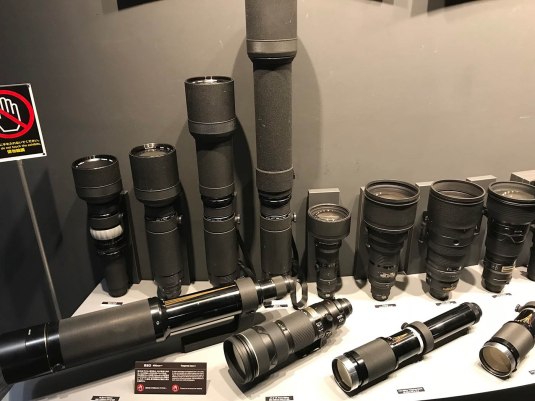 Nikon made interchangeable focusing units for their earlier super-telephoto lenses. This was handy for cutting cost but it became impractical because designing lenses with same focus ranges can be counter-productive and unnecessary so this gimmick was dropped.
Nikon made interchangeable focusing units for their earlier super-telephoto lenses. This was handy for cutting cost but it became impractical because designing lenses with same focus ranges can be counter-productive and unnecessary so this gimmick was dropped.
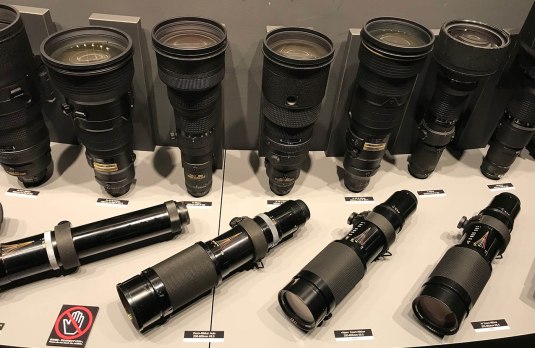 Then and now, this is how I would describe this picture. There’s at least about 4 decades of difference in design and technology between the lenses at the front and at the back,
Then and now, this is how I would describe this picture. There’s at least about 4 decades of difference in design and technology between the lenses at the front and at the back,
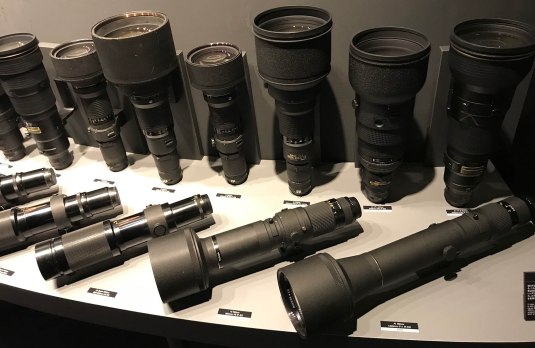 You think you’re strong enough to hand-hold these things while shooting birds?
You think you’re strong enough to hand-hold these things while shooting birds?
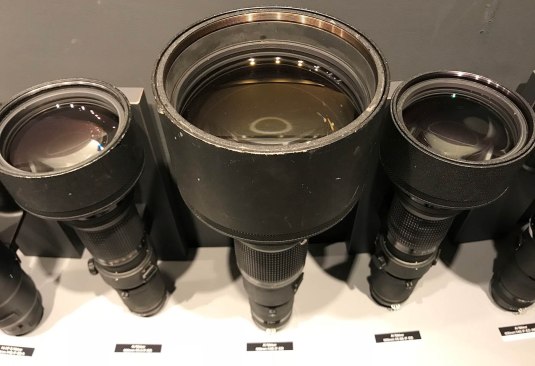 That’s a huge front element! I can barely wrap my hands around its circumference!
That’s a huge front element! I can barely wrap my hands around its circumference!
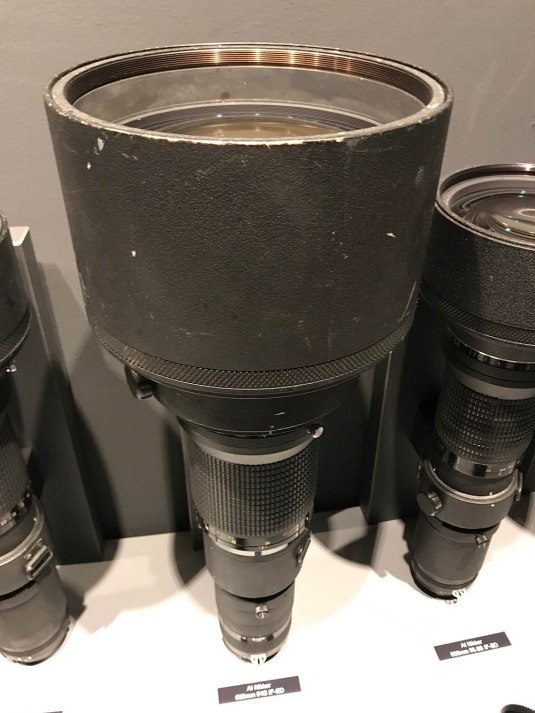 Here’s a closer view of that humongous front element. A bird photographer’s dream lens!
Here’s a closer view of that humongous front element. A bird photographer’s dream lens!
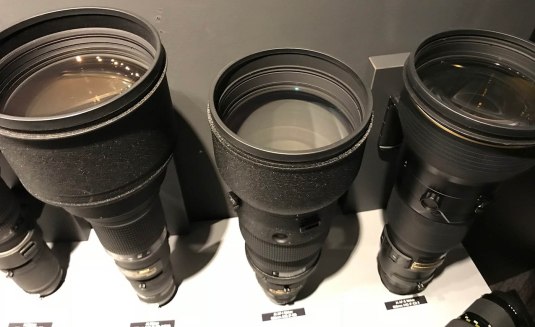 Now, these things look smaller compared to the monster that we just saw but they’re still big! These require special carrying cases to transport and no, they’re not back packs.
Now, these things look smaller compared to the monster that we just saw but they’re still big! These require special carrying cases to transport and no, they’re not back packs.
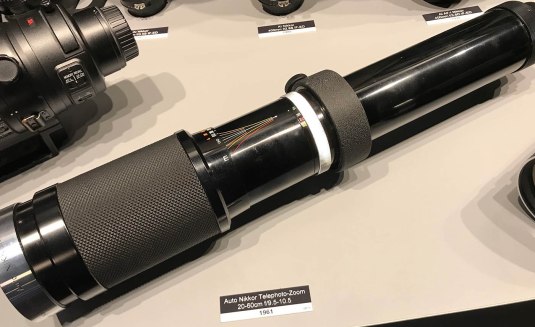 This is the ancestor of today’s NIKKOR 200-500mm f/5.6E AF-S ED VR super zoom. It’s a lot bigger and heavier but it doesn’t come with all the new features and it’s a lot slower.
This is the ancestor of today’s NIKKOR 200-500mm f/5.6E AF-S ED VR super zoom. It’s a lot bigger and heavier but it doesn’t come with all the new features and it’s a lot slower.
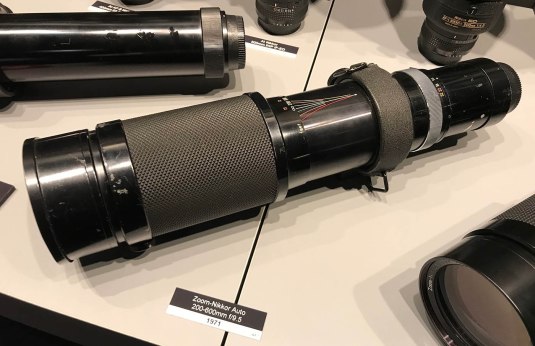 And here’s an upgrade.
And here’s an upgrade.
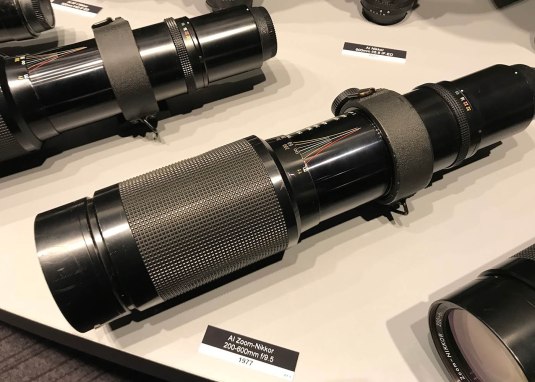 And another upgrade…
And another upgrade…
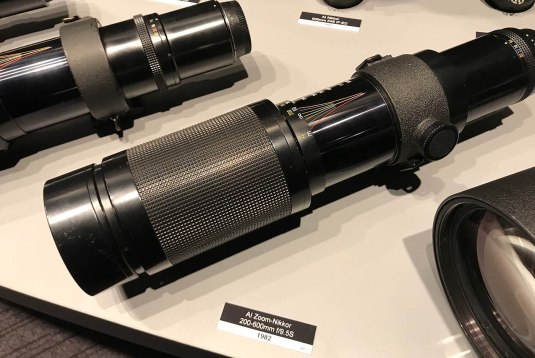 And it finally ended in 1982 as an Ai-S lens.
And it finally ended in 1982 as an Ai-S lens.
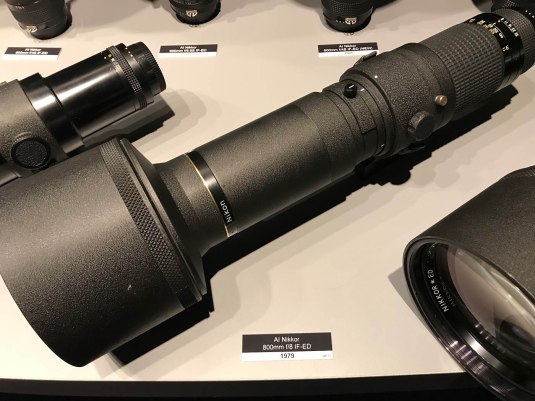 I like exotic women like Sadé, this lens is just as exotic as she is. I wonder when will I get the chance to score something like this. I don’t have a practical use for this to be honest.
I like exotic women like Sadé, this lens is just as exotic as she is. I wonder when will I get the chance to score something like this. I don’t have a practical use for this to be honest.
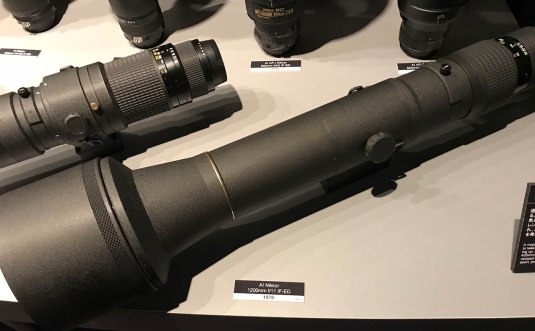 You call your lens a “bazooka”? Now, how’s this for a bazooka-lens? You will need a team of assistants to help you set this up quick when shooting in the field! I reckon you’ll need at least 5 minutes to set the tripod, lens and camera before you can shoot anything. News companies use these long lenses for taking pictures of dangerous situations like a terror attack or natural or man-made disasters. These are also great for surveillance and creep shots at the beach. I have experienced shooting with a 1200mm lens before and you can almost fill your frame with an object that is almost half a kilometer away.
You call your lens a “bazooka”? Now, how’s this for a bazooka-lens? You will need a team of assistants to help you set this up quick when shooting in the field! I reckon you’ll need at least 5 minutes to set the tripod, lens and camera before you can shoot anything. News companies use these long lenses for taking pictures of dangerous situations like a terror attack or natural or man-made disasters. These are also great for surveillance and creep shots at the beach. I have experienced shooting with a 1200mm lens before and you can almost fill your frame with an object that is almost half a kilometer away.
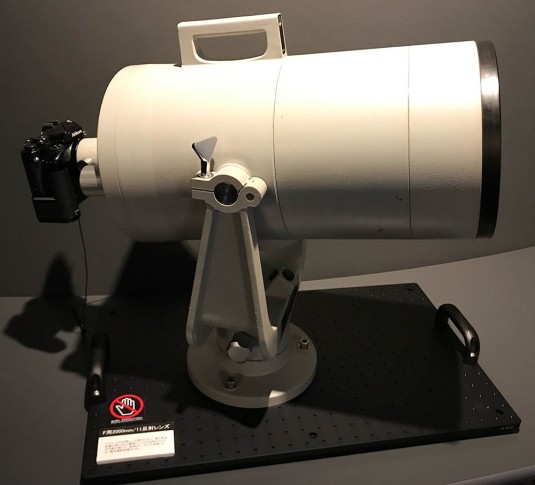 If 1200mm isn’t long enough for you then how about 2000mm? This lens is so big that it requires its own built-in mount! You got it right, it’s a mirror lens. Try making one using a refractive lens design and let’s see how big that will end up being. Come on, guess it.
If 1200mm isn’t long enough for you then how about 2000mm? This lens is so big that it requires its own built-in mount! You got it right, it’s a mirror lens. Try making one using a refractive lens design and let’s see how big that will end up being. Come on, guess it.
This is the last part of the series and I thank you for your patience in bearing with me on this series. It would be nice to shoot these with a proper setup for the blog but that is too troublesome for me and an iPhone is much better. I know the curator of the museum but that is not a reason for me to be unruly by pissing-off other visitors with my flash. Thank you guys again for following the blog and see you guys again next time! Love, Ric.
Help Support this Blog:
Maintaining this blog requires money to operate. If you think that this site has helped you or you want to show your support by helping with the upkeep of this site, you can simple make a small donation to my paypal.com account (richardHaw888@gmail.com). Money is not my prime motivation for this blog and I believe that I have enough to run this but you can help me make this site (and the companion facebook page) grow.
Helping support this site will ensure that this will be kept going as long as I have the time and energy for this. I would appreciate it if you just leave out your name or details like your country and other information so that the donations will totally be anonymous it is at all possible. This is a labor of love and I intend to keep it that way for as long as I can. Ric.
